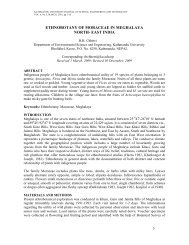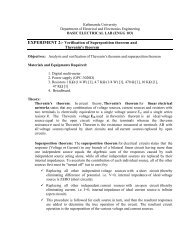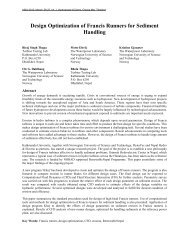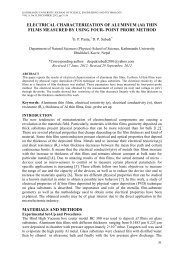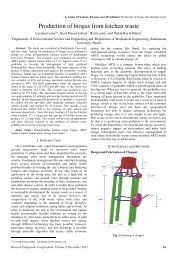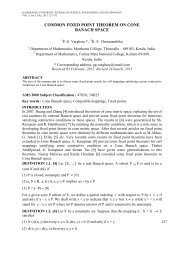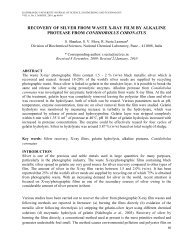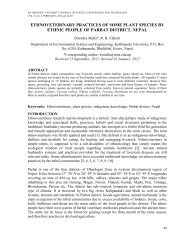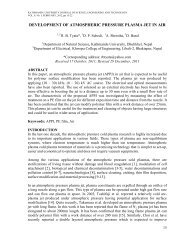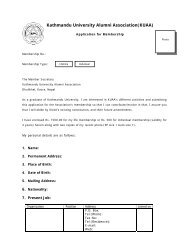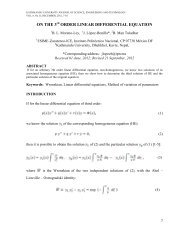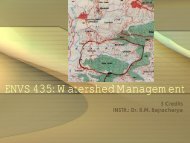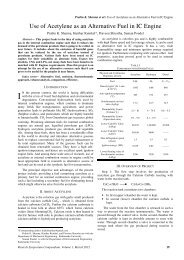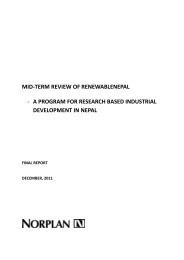monitoring of toxic metals - Kathmandu University
monitoring of toxic metals - Kathmandu University
monitoring of toxic metals - Kathmandu University
Create successful ePaper yourself
Turn your PDF publications into a flip-book with our unique Google optimized e-Paper software.
KATHMANDU UNIVERSITY JOURNAL OF SCIENCE, ENGINEERING AND TECHNOLOGY<br />
VOL. 6, No. II, NOVEMBER, 2010, pp 60-65<br />
Soil and environmental pollution is a matter <strong>of</strong> great concern and has been accepted as a global<br />
problem because <strong>of</strong> its adverse effect on human health, plants, animals and all exposed material to<br />
Cd, Pb, As and Hg (Irshad et al. 1997). Heavy metal <strong>toxic</strong>ity has received special attention<br />
globally due to neurotoxin, carcinogenic and several other impacts arising from their consumption<br />
even at lower contents. (Sathawara, et al., 2004). Prolonged accumulation <strong>of</strong> heavy <strong>metals</strong><br />
through food stuff may lead to chronic effect in the kidney and liver <strong>of</strong> humans and causes<br />
disruption <strong>of</strong> numerous biochemical processes leading to cardiovascular, nervous, kidney and<br />
bone diseases (Jarup, 2003). Modern analytical techniques and ultra sensitive instruments<br />
analyzing metal contents even at ppb levels have recently resolved several health disorders<br />
associated with intake <strong>of</strong> <strong>toxic</strong> <strong>metals</strong>. Recent developments in <strong>toxic</strong>ities and other disorders<br />
resulting from ingestion <strong>of</strong> <strong>toxic</strong> <strong>metals</strong> have compelled food regulators around the world to<br />
revise the safe limits <strong>of</strong> these <strong>toxic</strong>ants to ensure consumer health.<br />
Soil eco-system throughout world has been contaminated with heavy <strong>metals</strong> by various human<br />
activities and movement <strong>of</strong> <strong>metals</strong> in food chain has become human health hazard (Zahir et al.,<br />
2009). Land contamination with heavy <strong>metals</strong> is increasing and becoming environmental,<br />
economic and planning issue in Pakistan (Bhutto et al., 2009).<br />
Soil chemical composition plays important role in composition <strong>of</strong> plant materials. Overall <strong>toxic</strong><br />
metal availability in soil rhizosphere contributes to metal contents in fruits/ vegetables.<br />
Anthropogenic activity such as application <strong>of</strong> fertilizers, manures also affect soil metal content<br />
(e.g. phosphatic fertilizers being main source <strong>of</strong> Cd impurity). Soils in Pakistan contain Pb and Cd<br />
at sufficient levels (Ahmed et al., 1994). Perveen et al. (2003) reported the presence <strong>of</strong> Cd and Pb<br />
concentration <strong>of</strong> 0.08 µgg -1 and 0.12 µgg -1 respectively <strong>toxic</strong> <strong>metals</strong> at lower concentration.<br />
Sharma et al. (2009) also reported Cd, Pb and As at 0.6 µgg -1 , 0.15 µgg -1 and 0.008 µgg -1<br />
respectively in leafy and fruity vegetables. Leafy vegetables accumulate much higher contents <strong>of</strong><br />
heavy <strong>metals</strong> as compare to other vegetables because leafy vegetables are most exposed to<br />
environmental pollution because <strong>of</strong> large surface area (Itanna et al., 2002). Considering the<br />
significance <strong>of</strong> these <strong>metals</strong> and food consumption patterns, a detailed study was carried out to<br />
monitor levels <strong>of</strong> lead, cadmium, arsenic and mercury in different vegetables grown in the<br />
province <strong>of</strong> Sindh. The aim <strong>of</strong> this study was to monitor the <strong>toxic</strong> heavy <strong>metals</strong> Cd, Pb, As and Hg<br />
in vegetables.<br />
MATERIALS AND METHODS<br />
Two hundred ten (210) samples <strong>of</strong> vegetables i.e. leafy vegetables (Coriander, Methi, Spinach and<br />
Mint), root and tuberous vegetables (Arum, Onion, Potato, Radish, Sugar Beet and Turnip),<br />
cucurbit vegetables (Bitter Gourd, Cucumber, Indian Squash and Pumpkin) and fruity vegetables<br />
(Brinjal, Cabbage, Cauliflower, Chilies, French Beans, Okra and Tomato) were collected from<br />
farmers’ field <strong>of</strong> Khairpur, Sukkur, Hydrabad and Karachi district and from exporters <strong>of</strong> Karachi.<br />
Samples were placed in polyethylene bags and brought to laboratory for analysis. All samples<br />
were washed with tape water followed with DDI (double de-ionized distil water). Samples were<br />
cut in into small pieces and dried at 105°C for 18 hours (Wiermans et al., 1986). After drying the<br />
samples were ground into powder form. Approximately 1.0 g <strong>of</strong> each sample in duplicate taken<br />
into digestion tubes, were soaked in 40ml <strong>of</strong> nitric acid and perchloric acid (3:1) and left<br />
overnight for complete contact <strong>of</strong> material. Next day, samples were digested first at 120°C for 2<br />
hrs and then 180°C on heating digester (VELP Scientifica) till the solution becomes transparent.<br />
Digestion stopped when sample solution reduced to 2-3 ml. Cooled samples were transferred into<br />
61



